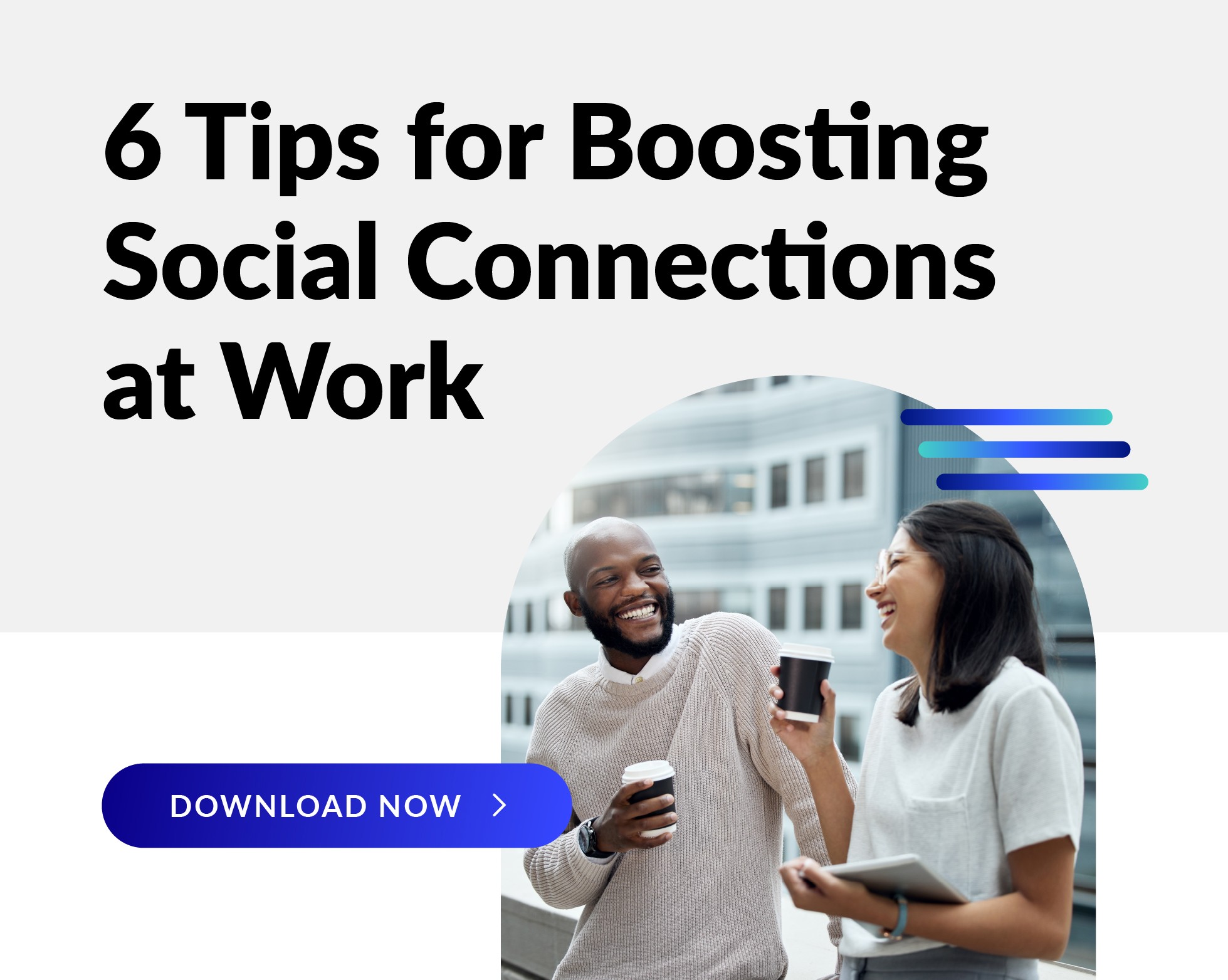 What’s it like to be an employee at your company today? Chances are, the “employee experience” is a lot different now than it was two years ago. How employees feel about coming to work each day has enormous implications for engagement and the health of the business. In this week’s blog, we discuss what makes for a good employee experience and share tips for building a strategy to achieve it.
What’s it like to be an employee at your company today? Chances are, the “employee experience” is a lot different now than it was two years ago. How employees feel about coming to work each day has enormous implications for engagement and the health of the business. In this week’s blog, we discuss what makes for a good employee experience and share tips for building a strategy to achieve it.
What is the employee experience, and why is it important?
Employee experience sums up what it’s like to work at a company. It’s all the interactions that employees have throughout the day with people, systems, policies, and the physical and virtual workspace.1 You may have seen it abbreviated as “EX.”
To improve employee experience, some companies have focused on administrative processes, such as easier time-keeping or travel reimbursement. Those kinds of things can be time-consuming and frustrating, so simplifying them does improve the work experience. Others have added more benefits and perks, like trendy pet insurance or pool tables.
But there’s a lot more to it. As Mercer suggests, HR would do well to “shift its mindset from optimizing ‘things’ for employees (e.g., programs and processes) and instead design an end-to-end experience that employees long to be a part of.” PwC writes, “the goal of providing a strong employee experience isn’t to make your people feel warm and fuzzy. It’s to enable them to do their best work—to make them want to come to work.”
So what does this mean? It means focusing on the more intangible stuff that can influence how people feel about showing up every day. Many argue we should be treating our employees like we treat our customers—seeking daily to delight them—and that doing so directly impacts the bottom line.
Diane Gherson, former chief human resources officer at IBM, puts it like this: “…we started with the belief that if people felt great about working with us, our clients would too. We’ve found that employee engagement explains two-thirds of our client experience scores. And if we’re able to increase client satisfaction by five points on an account, we see an extra 20% in revenue, on average. So clearly there’s an impact. That’s the business case for the change.”
The pandemic has made the employee experience even more important. Dina Love, a vice president in Gartner’s HR practice, says, “The days of showing up for work simply to collect a paycheck and get some benefits are over. The pandemic exposed the limits of that transactional relationship, and leading employers will respond accordingly.” And they are. A 2021 Willis Towers Watson Employee Experience Survey found that 92% of employers say enhancing the EX will be a priority over the next three years.
What makes for a good employee experience?
Making sure that employees feel cared for in all aspects of their lives—physically, emotionally, and financially—from their first to their last day on the job. Providing support for the parts of life that occur outside of the workday. Focusing on workplace culture. Below are some examples that contribute to building a good employee experience strategy.
Top-notch onboarding.
It seems like a no-brainer that an employee’s first moments with a company should be nothing short of awe-inspiring. Yet, in a recent study by Gallup, just 12% of people felt their company does a good job onboarding new team members. So make sure the onboarding experience—which technically begins the moment the candidate accepts the offer—delights. This includes:
- Smooth IT onboarding
- Structured activities, especially during that first week
- Assigning a mentor
- Planning meetings with people from other departments and leadership
- Regular check-ins for at least 90 days
Connection to the corporate mission.
Employees increasingly want to feel that their work has meaning and purpose. Make the connection between an individual’s work and how it contributes to the company’s mission and society through regular communication from all levels of the organization—from leaders to managers.
Consistent communication.
Organizations who maintain a regular cadence of transparent communication with employees, especially during times of change, tend to have a better employee experience. Communicate frequently with town halls, videos from leaders, workplace social media posts, and chat groups. All of these vehicles build trust and loyalty and ensure that employees feel they are “in the know.”
Community.
Employees look to the workplace for that sense of community they may be missing in our disconnected world. Focusing on community can increase engagement and commitment to a company and be as simple as a regular happy hour or volunteering for a local charity together.
An inclusive, diverse culture.
There are strong linkages between diverse, inclusive cultures and a positive employee experience. A good employee experience is nurtured when people feel they can bring their whole selves to work and don’t have to hide any part of their identity.
Support for all aspects of well-being.
Focusing on employee well-being means more than offering an onsite gym or healthy food in the cafeteria. A good employee experience includes support for all the dimensions of well-being: physical, clinical, financial, mental health, and social connections. It also includes help for the parts of life that happen outside the workday—like elder and child care benefits. A robust wellness communication strategy is critical for ensuring that employees know about and can take advantage of these benefits.
A comfortable work environment.
It’s critical to create an office space that allows people to do their best work, especially now that many people have become used to working from home. This includes places for people to collaborate or do focused work, and even small things like ensuring that the office temperature is comfortable. And for those continuing to work from home, we need to ensure that all the supports are there, too—like ergonomic workstations, supplies, decent internet connections, and more.
Flexibility.
Employees want the flexibility to schedule work when and where it’s best for their lives, whether that’s leaving early to pick up a child at school or taking Friday afternoons off to pursue a personal passion. Allowing employees flexibility—with the expectation that the work will get done—creates trust, boosts engagement, and contributes to a positive employee experience.
Recognition.
Regularly recognizing the hard work and contributions of team members provides a sense of accomplishment, decreases stress, and increases feelings of connection and belonging—all of which translate to a better employee experience. You don’t have to have a formal recognition platform—even handwritten notes or small tokens are appreciated.
Regular touch points with managers.
Frequent, informal check-ins between an employee and their manager have been shown to decrease employee burnout. Managers need to use this time to connect with direct reports on a deeper level—acknowledging the human side of their employees, which we know to be a key driver of engagement.
What makes a good employee experience strategy?
There are several ways to approach developing or enhancing the employee experience. While not an exhaustive list, here are seven best practice steps to consider:
1. Do your research.
Any organizational change should start with listening. What do employees want from the experience of working at your company? Some questions you can include in focus groups or pulse surveys are:
- How do you feel about working here?
- Do you feel our culture aligns with your own values and beliefs?
- Do you understand how your role relates to our overall mission?
- Do you have a clear path for your career advancement?
- How do you feel about the support you receive from your manager?
- Do you feel our company supports you in multiple aspects of your life, not just at work?
- Does our technology allow you to work smartly and efficiently?
2. Consider all types of employees.
To be inclusive, it’s essential to learn how different types of employees experience the workplace. It may help to develop employee “personas” to get underneath what’s important to people. Some personas might be: in-person/remote workers; members of different generations; racial/ethnic identity; men/women/non-binary; full-time/part-time; managers/individual contributors, and other population segments.
3. Create a vision for your employee experience.
Once you’ve conducted some listening and created employee personas, it’s helpful to lay out a template for what you want the employee experience to look like. Consider things like how people should work together and communicate with each other, how to connect work to the company’s larger purpose, where work gets done, how employees can advance in their careers, and what types of programs and resources may be needed to more fully support employees.
4. Get leaders on board.
Now that you’ve got your vision, it’s time to enlist support from leadership. As with any change management initiative, leadership backing is critical, and everyone from the top down must model this vision for it to be successful. It’s also vital that the team structure of your EX initiative represents members from all parts of the organization—not just HR. This will help create buy-in and reduce any skepticism about the effort’s importance.
5. Build your communication competency ahead of time.
It’s important to think about the communication channels you’ll use to make all the pieces of your employee experience strategy come alive. Tap into established channels like your corporate intranet, email, town halls and regular all-employee meetings. Workplace social media and Slack channels can also generate a positive buzz. Managers should also receive talking points and slides to use in team huddles.
6. Support your managers.
Managers are the face of the organization to employees, so they need to be prepared and supported in carrying out the employee experience vision. For example, they need training on:
- How to coach employees and give good feedback.
- How to be flexible and help employees in ways that may be uncomfortable, like talking about mental health.
- How to chart a course for career advancement and learning that will make employees want to remain with the organization.
7. Regularly check in with employees.
A good employee experience will need to be tweaked from time to time to respond to changing employee wants and needs. The best way to keep on top of this is to incorporate regular measurement and feedback. Periodic engagement surveys are a good way to do this. You can also gather feedback in real-time by asking employees to respond to daily pulse checks, using a stoplight approach or mood emoji. IBM’s Diane Gherson calls this frequent check-in approach “sentiment analysis,” which gives you a sense of “where you’ve got trouble spots, where your management isn’t strong enough, where groups of people are expressing negative opinions.”
Particularly in today’s tight labor market, the importance of a good employee experience can’t be underestimated. But, labor shortage or not, ensuring that each employee’s journey through the organization is positive will always be vital to boosting employee engagement, reducing costly turnover, and ensuring employee well-being.




